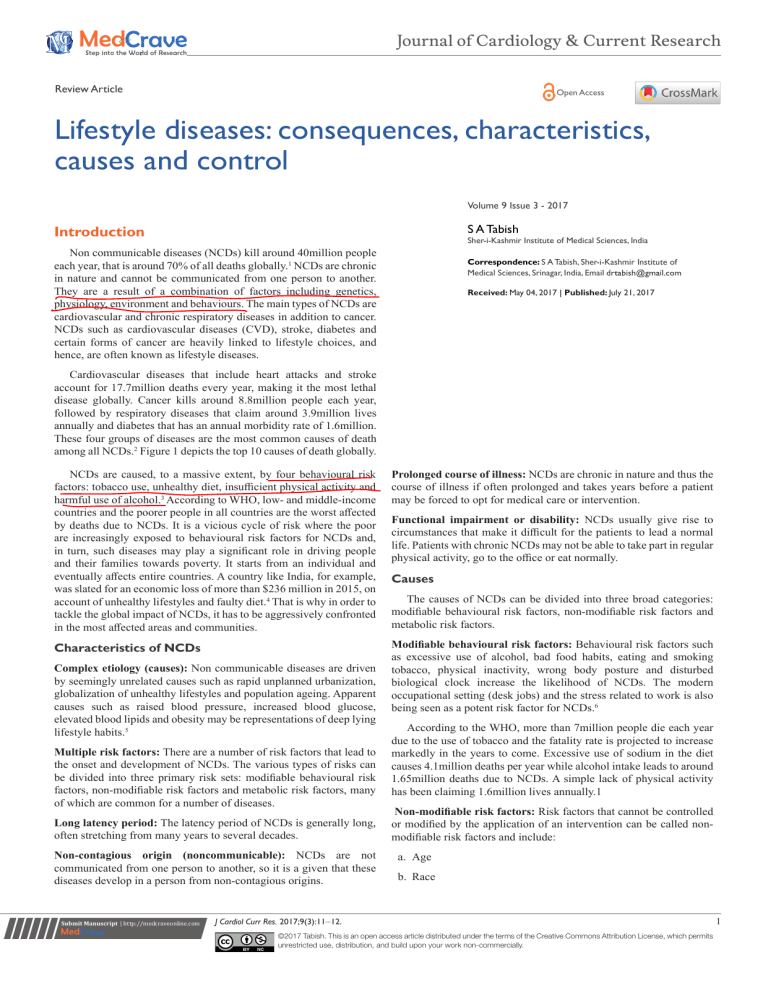Lifestyle Diseases: Consequences, Characteristics, Causes & Control
advertisement

Journal of Cardiology & Current Research Review Article Open Access Lifestyle diseases: consequences, characteristics, causes and control Volume 9 Issue 3 - 2017 S A Tabish Introduction Sher-i-Kashmir Institute of Medical Sciences, India Non communicable diseases (NCDs) kill around 40million people each year, that is around 70% of all deaths globally.1 NCDs are chronic in nature and cannot be communicated from one person to another. They are a result of a combination of factors including genetics, physiology, environment and behaviours. The main types of NCDs are cardiovascular and chronic respiratory diseases in addition to cancer. NCDs such as cardiovascular diseases (CVD), stroke, diabetes and certain forms of cancer are heavily linked to lifestyle choices, and hence, are often known as lifestyle diseases. Correspondence: S A Tabish, Sher-i-Kashmir Institute of Medical Sciences, Srinagar, India, Email Received: May 04, 2017 | Published: July 21, 2017 Cardiovascular diseases that include heart attacks and stroke account for 17.7million deaths every year, making it the most lethal disease globally. Cancer kills around 8.8million people each year, followed by respiratory diseases that claim around 3.9million lives annually and diabetes that has an annual morbidity rate of 1.6million. These four groups of diseases are the most common causes of death among all NCDs.2 Figure 1 depicts the top 10 causes of death globally. NCDs are caused, to a massive extent, by four behavioural risk factors: tobacco use, unhealthy diet, insufficient physical activity and harmful use of alcohol.3 According to WHO, low- and middle-income countries and the poorer people in all countries are the worst affected by deaths due to NCDs. It is a vicious cycle of risk where the poor are increasingly exposed to behavioural risk factors for NCDs and, in turn, such diseases may play a significant role in driving people and their families towards poverty. It starts from an individual and eventually affects entire countries. A country like India, for example, was slated for an economic loss of more than $236 million in 2015, on account of unhealthy lifestyles and faulty diet.4 That is why in order to tackle the global impact of NCDs, it has to be aggressively confronted in the most affected areas and communities. Prolonged course of illness: NCDs are chronic in nature and thus the course of illness if often prolonged and takes years before a patient may be forced to opt for medical care or intervention. Characteristics of NCDs Modifiable behavioural risk factors: Behavioural risk factors such as excessive use of alcohol, bad food habits, eating and smoking tobacco, physical inactivity, wrong body posture and disturbed biological clock increase the likelihood of NCDs. The modern occupational setting (desk jobs) and the stress related to work is also being seen as a potent risk factor for NCDs.6 Complex etiology (causes): Non communicable diseases are driven by seemingly unrelated causes such as rapid unplanned urbanization, globalization of unhealthy lifestyles and population ageing. Apparent causes such as raised blood pressure, increased blood glucose, elevated blood lipids and obesity may be representations of deep lying lifestyle habits.5 Multiple risk factors: There are a number of risk factors that lead to the onset and development of NCDs. The various types of risks can be divided into three primary risk sets: modifiable behavioural risk factors, non-modifiable risk factors and metabolic risk factors, many of which are common for a number of diseases. Long latency period: The latency period of NCDs is generally long, often stretching from many years to several decades. Non-contagious origin (noncommunicable): NCDs are not communicated from one person to another, so it is a given that these diseases develop in a person from non-contagious origins. Submit Manuscript | http://medcraveonline.com Functional impairment or disability: NCDs usually give rise to circumstances that make it difficult for the patients to lead a normal life. Patients with chronic NCDs may not be able to take part in regular physical activity, go to the office or eat normally. Causes The causes of NCDs can be divided into three broad categories: modifiable behavioural risk factors, non-modifiable risk factors and metabolic risk factors. According to the WHO, more than 7million people die each year due to the use of tobacco and the fatality rate is projected to increase markedly in the years to come. Excessive use of sodium in the diet causes 4.1million deaths per year while alcohol intake leads to around 1.65million deaths due to NCDs. A simple lack of physical activity has been claiming 1.6million lives annually.1 Non-modifiable risk factors: Risk factors that cannot be controlled or modified by the application of an intervention can be called nonmodifiable risk factors and include: a. Age b. Race J Cardiol Curr Res. 2017;9(3):11‒12. ©2017 Tabish. This is an open access article distributed under the terms of the Creative Commons Attribution License, which permits unrestricted use, distribution, and build upon your work non-commercially. 1 Copyright: ©2017 Tabish Lifestyle diseases: consequences, characteristics, causes and control c. Gender Major Modifiable Risk Factors d. Genetics Metabolic risk factors: Metabolic risk factors lead to four major changes in the metabolic systems that increase the possibility of NCDs: i. Increased blood pressure ii. Obesity iii. Increased blood glucose levels or hyperglycemia Increased blood pressure is the leading metabolic risk factor globally with 19% of the global deaths attributed to it, followed by obesity and hyperglycermia. 1 WHO (2017). Noncommunicable diseases. Fact Sheet. (Retrieved from: 2 High blood pressure Abnormal blood Age Heredity or lipids Tobacco use family history Physical inactivity Gender Ethnicity Obesity Unhealthy diet or race (salt) Diabetes Heavy alcohol use Other Risk Factors Excess homocysteine in blood - Inflammatory markers (Creactive protein) Abnormal blood coagulation (elevated blood levels of fibrinogen) Lipoprotein(a) Major Modifiable Risk Non-Modifiable Risk Other Risk Factors Factors Factors iv. Increased levels of fat in the blood or hyperlipidemia http://www.who.int/mediacentre/factsheets/fs355/en/ 2/05/2017) Non-Modifiable Risk Factors 2 on: ibid 3 WHO (2011). Global status report on noncommunicable diseases 2010. (Retrieved from http://www.who.int/nmh/publications/ncd_report_full_en.pdf on 1/05/2017) WHO/WEF (2008). Preventing noncommunicable diseases in the workplace through diet and physical activity: World Health Organisation/World Economic Forum report of a joint event. 4 Aryal KK, Mehata S, Neupane S, Vaidya A, Dhimal M, et al. (2015). The Burden and Determinants of Non Communicable Diseases Risk Factors in Nepal: Findings from a Nationwide STEPS Survey. PLoS ONE, 10(8), e0134834. 5 Sharma M, Majumdar PK (2009). Occupational lifestyle diseases: An emerging issue. Indian Journal of Occupational and Environmental Medicine, 13(3), 109–112. Unhealthy diets Physical Inactivity Obesity or Overweight High Advacnced age Family Blood Pressure High Presence of history/genetics Race Cholesterol Heavy autoantibodies Low Distribution of fat in the alcohol use Psychological socioeconomic status body stress High consumption of sugar Low consumption of fiber Cancer Cancer affects different parts of the body and is characterised by a rapid creation of abnormal cells in that part and can invade other parts of the body as well. More than 7million people die of cancer each year and 30% of those diseases are attributed to lifestyle choices.8 Type Of Cancer Modifiable Risk Factors Other Risk Factors Cervical cancer Smoking Poverty Human papilloma virus infection (hpv) Immune deficiencies Family history Lung cancer Smoking Second hand smoke Radiation therapy Being exposed to asbestos, radon, chromium, nickel, arsenic, soot, or tar Living in air-polluted place Breast cancer Hormone therapies Weight and physical activity Race Genetics BRCA1 and BRCA2 genes Age Prostate cancer Obesity Bad food habits Low intake of fiber Age Race Colorectal cancer Unhealthy diet Insufficient physical Age Race Family history activity Diabetes 6 Four major lifestyle diseases CVD Cardiovascular diseases are a group of disorders of the heart and blood vessels and may include: A. Ischaemic heart disease B. Stroke C. Peripheral arterial disease D. Congenital heart disease CVDs are the number 1 cause of death globally and account for more than 17million deaths per year. The number is estimated to rise by 2030 to more than 23million a year.7 Diabetes Diabetes is a metabolism disorder that affects the way the body used food for energy and physical growth. There are 4 types of diabetes: Type 1, Type 2, Gestational, and Pre-Diabetes (Impaired Glucose Tolerance). Type 2 is the most common diabetes in the world and is caused by modifiable behavioural risk factors. Chronic respiratory diseases Some of the most under-diagnosed conditions, chronic respiratory diseases (CRD) are a potent cause of death globally with 90% of the deaths taking place in low-income countries. Chronic obstructive pulmonary disease (COPD) and asthma are the two main types of CRDs. Modifiable Risk Factors Non-Modifiable Risk Factors Cigarette smoke Dust and chemicals Environmental tobacco smoke Air pollution Genetics Age Infections CVD – A global epidemic As stated earlier, CVD is the number one cause for deaths globally and the number of people dying from it each year is constantly rising. It is estimated that by 2030, CVD will be responsible for more deaths in Citation: Tabish SA. Lifestyle diseases: consequences, characteristics, causes and control. J Cardiol Curr Res. 2017;9(3):1‒6. DOI: 10.15406/jccr.2017.09.00326 Copyright: ©2017 Tabish Lifestyle diseases: consequences, characteristics, causes and control low income countries than infectious diseases, maternal and perinatal conditions, and nutritional disorders combined.9 Figure 2 highlights the prominence of CVD in global mortality trends in comparison to other causes. CVDs are the face of lifestyle diseases and manifest in a number of ways, such as: Coronary heart disease (CHD): Also known as coronary heart disease and ischaemic heart disease, CHD is one of the most common types of heart problems faced today and is characterised by a reduction or blockage in the flow of oxygen-rich blood to the heart muscle. This puts exaggerated strain on the heart, which can lead to: a. Angina – chest pain caused by lack of flow of blood to the heart b. Heart attacks – caused when the blood flow to the heart is suddenly but completely blocked c. Heart failure – the failure of the heart to pump blood properly to the rest of the body Cerebrovascular disease (strokes and TIAs): Cerebrovascular disease is the disease of blood vessels supplying blood to the brain. When the blood supply to the brain is cut off, a person suffers a stroke, which can be lethal. A transient ischaemic attack, popularly known as a mini-stroke, occurs when the blood supply to the brain is temporarily blocked. The acronym FAST is used to signify the symptoms of a stroke or TIA.10 It stands for: a. Face: Face drooping on one side is the most common visible symptom, followed by dropping of mouth or eye. b. Arms: Weakness of numbness in one or both arms doesn’t allow a person to raise both of his or her hands up and hold them there. c. Speech: Slurred or garbled speech in some cases, and in other cases: no speech. d. Time: It is time to call the emergency services if you see any of these symptoms. Other symptoms include: i. Blurred or complete loss of vision in one or both eyes ii. One-sided weakness or numbness of the body iii. Sudden memory loss or confusion iv. Sudden dizziness combined with any of the above mentioned symptoms can be a definite sign Peripheral arterial disease: Peripheral arterial diseases is a disease of blood vessels supplying the arms and legs. It happens when there is a blockage in the arteries to the limbs (usually the legs). Signs to watch out for: a. Dull or cramping pain that gets worse with walking and better with rest b. Hair loss on the limbs c. Numbness or weakness in the limbs d. Persistent ulcers on the legs and feet Rheumatic heart disease: Rheumatic heart disease is characterised by damage to the heart muscle and heart valves from rheumatic 3 fever, caused by streptococcal bacteria. Some of the most common symptoms are fever and painful, tender joints. Congenital heart disease: Congenital heart disease is a problem with the structure of the heart, i.e. malformations of heart structure, that exist at birth. The problem can range from a small hole in the heart to a more severe problem such as a defective heart muscle. Some of the common symptoms are shortness of breath and having trouble exercising. In infants and younger kids, cyanosis, a bluish tint to the skin, fingernails and lips can be an important marker. Risk factors include: i. Use of certain medications, drugs or alcohol during pregnancy ii. Viral infections in the mother in the first trimester iii. Genetic problems or issues with chromosomes of the child Pulmonary embolism due to deep vein thrombosis (DVT): DVTs are blood clots, often found in the veins of the legs, which can dislodge and move to the heart and lungs, causing pulmonary embolism. This condition can be life-threatening and special care should be taken if diagnosed with DVT. Symptoms include: a. Chest pain – may get worse with deep breaths b. Sudden shortness of breath c. Sudden cough or coughing up blood d. Anxiety e. Light-headedness and fainting Aortic disease: Aortic diseases are a group of conditions that affect the aorta, the largest blood vessel in the body. The aorta is responsible for carrying blood from the heart to the rest of the body. An example of an aortic disease would be aortic aneurism, where the walls of the aorta are weakened, leading to outward bulging of the blood vessel. Usually symptomless, this condition can lead to life-threatening circumstances if it bursts. Managing CVD: Depending on the type of CVD, an appropriate treatment plan can help alleviate the problem/s. There are a number of treatments ranging from medication to surgeries that can help, however, prevention is always recommended over treatment. To prevent CVD, one must: a. Stop smoking b. Have a balanced diet with plenty of fibre c. Exercise regularly (>150minutes of aerobic activity per week) d. Maintain a healthy weight and body mass index (BMI; aim for a BMI below 25) e. Cut down on alcohol (<14 alcohol units per week) Aspirin and anti-platelet therapy11 Control and prevention of lifestyle diseases An important way of controlling non-communicable diseases is by controlling the risk factors associated with it. In other words, a number of communicable diseases can be prevented by controlling the behavioural or lifestyle habits associated with those diseases. There are a number of low-cost solutions that can be implemented by the government and other involved groups to reduce the common modifiable risk factors.1 Monitoring the trends of non -communicable Citation: Tabish SA. Lifestyle diseases: consequences, characteristics, causes and control. J Cardiol Curr Res. 2017;9(3):1‒6. DOI: 10.15406/jccr.2017.09.00326 Copyright: ©2017 Tabish Lifestyle diseases: consequences, characteristics, causes and control 4 diseases and their associated risks is crucial for guiding policies and guidelines. Beaglehole R, Bonita R. (2008). Global public health: A scorecard. Lancet, 372(9654):1988–1996. A comprehensive approach is essential that involves all sectors including health, finance, education, planning and others, to minimise the impact of lifestyle diseases on individuals and society. The approach needs to instigate a collaborative effort to minimise the risks associated with no communicable diseases and at the same time inspire interventions to control and prevent them. 10 NHS (2017). Act F.A.S.T. if you think someone is having a stroke. NHS information leaflet. (Retrieved from: http://www.nhs.uk/actfast/ Documents/ActFAST_Leaflet2017_EasyRead.pdf on 1/05/2017) Lifestyle diseases are a threat to the socio-economic aspects of nations globally and appropriate actions for their management are the need of the moment. Management of lifestyle diseases includes proper diagnosis, screening and treatment of these diseases in addition to providing palliative care for people who require it. Quality lifestyle disease intervention needs to be delivered through a primary healthcare approach where early detection and proper treatment are prioritised.4 Mathers CD, Loncar D (2006). Projections of Global Mortality and Burden of Disease from 2002 to 2030.PLoS Medicine, 3(11), e442. 7 9 11 Wong ND (2015) Epidemiology and prevention of cardiovascular disease. In Detels, R., Gulliford, M, et al. Oxford Textbook of Global Public Health (6 ed.). Oxford University Press. Acknowledgments None. Conflicts of interest Author declares there are no conflicts of interest. Funding None. WHO (2017) Cancer. Fact Sheet. (Retrieved from: http://www. who.int/mediacentre/factsheets/fs297/en/ on 1/05/2017) 8 Citation: Tabish SA. Lifestyle diseases: consequences, characteristics, causes and control. J Cardiol Curr Res. 2017;9(3):1‒6. DOI: 10.15406/jccr.2017.09.00326




